Estimation of Potato Canopy Nitrogen Content Based on Hyperspectral Index Optimization
Abstract
1. Introduction
2. Materials and Methods
2.1. Overview of the Study Area
2.2. Data Acquisition and Preprocessing
2.2.1. Hyperspectral Image Acquisition and Preprocessing
2.2.2. Measurement of CNC
2.3. Spectrum Data Processing and Index Construction
2.4. CNC Estimation Model and Evaluation Criteria
3. Results and Analysis
3.1. Statistical Analysis of CNC Data
3.2. Analysis of Canopy Spectral Characteristics under Different Transformations
3.3. Correlation between CNC and HTs w.r.t Bands
3.4. CNC Estimation of Potatoes Based on HIs
3.4.1. Estimation of Potato CNC Using ULR Model
3.4.2. Estimating Potato CNC Using MLR and PLSR Models
4. Discussion
5. Conclusions
Author Contributions
Funding
Institutional Review Board Statement
Informed Consent Statement
Data Availability Statement
Conflicts of Interest
References
- Wang, N.; Reidsma, P.; Pronk, A.A.; de Wit, A.J.W.; van Ittersum, M.K. Can potato add to China’s food self-sufficiency? The scope for increasing potato production in China. Eur. J. Agron. 2018, 101, 20–29. [Google Scholar] [CrossRef]
- Li, Y.; Tang, J.Z.; Wang, J.; Zhao, G.; Yu, Q.; Wang, Y.X.; Hu, Q.; Zhang, J.; Pan, Z.H.; Pan, X.B.; et al. Diverging water-saving potential across China’s potato planting regions. Eur. J. Agron. 2022, 134, 126450. [Google Scholar] [CrossRef]
- Morier, T.; Cambouris, A.N.; Chokmani, K. In-Season Nitrogen Status Assessment and Yield Estimation Using Hyperspectral Vegetation Indices in a Potato Crop. Agron. J. 2015, 107, 1295–1309. [Google Scholar] [CrossRef]
- Wang, N.; Reidsma, P.; van Ittersum, M.K. Scope and strategies for sustainable intensification of potato production in Northern China. Agron. J. 2020, 112, 3591–3604. [Google Scholar] [CrossRef]
- Li, B.; Xu, X.M.; Zhang, L.; Han, J.W.; Bian, C.S.; Li, G.C.; Liu, J.G.; Jin, L.P. Above-ground biomass estimation and yield prediction in potato by using UAV-based RGB and hyperspectral imaging. ISPRS-J. Photogramm. Remote Sens. 2020, 162, 161–172. [Google Scholar] [CrossRef]
- Tong, Q.X.; Xue, Y.Q.; Zhang, L.F. Progress in Hyperspectral Remote Sensing Science and Technology in China Over the Past Three Decades. IEEE J. Sel. Top. Appl. Earth Observ. Remote Sens. 2014, 7, 70–91. [Google Scholar] [CrossRef]
- Monforte, P.; Ragusa, M.A. Temperature Trend Analysis and Investigation on a Case of Variability Climate. Mathematics 2022, 10, 2202. [Google Scholar] [CrossRef]
- Liu, J.; Xiang, J.J.; Jin, Y.J.; Liu, R.H.; Yan, J.N.; Wang, L.Z. Boost Precision Agriculture with Unmanned Aerial Vehicle Remote Sensing and Edge Intelligence: A Survey. Remote Sens. 2021, 13, 4387. [Google Scholar] [CrossRef]
- Nigon, T.J.; Mulla, D.J.; Rosen, C.J.; Cohen, Y.; Alchanatis, V.; Knight, J.; Rud, R. Hyperspectral aerial imagery for detecting nitrogen stress in two potato cultivars. Comput. Electron. Agric. 2015, 112, 36–46. [Google Scholar] [CrossRef]
- Weiss, M.; Jacob, F.; Duveiller, G. Remote sensing for agricultural applications: A meta-review. Remote Sens. Environ. 2020, 236, 111402. [Google Scholar] [CrossRef]
- Sishodia, R.P.; Ray, R.L.; Singh, S.K. Applications of Remote Sensing in Precision Agriculture: A Review. Remote Sens. 2020, 12, 3136. [Google Scholar] [CrossRef]
- Peng, J.X.; Manevski, K.; Korup, K.; Larsen, R.; Andersen, M.N. Random forest regression results in accurate assessment of potato nitrogen status based on multispectral data from different platforms and the critical concentration approach. Field Crop. Res. 2021, 268, 108158. [Google Scholar] [CrossRef]
- Peng, Y.; Fan, M.; Wang, Q.H.; Lan, W.J.; Long, Y.T. Best hyperspectral indices for assessing leaf chlorophyll content in a degraded temperate vegetation. Ecol. Evol. 2018, 8, 7068–7078. [Google Scholar] [CrossRef] [PubMed]
- Zhang, H.Y.; Ren, X.X.; Zhou, Y.; Wu, Y.P.; He, L.; Heng, Y.R.; Feng, W.; Wang, C.Y. Remotely assessing photosynthetic nitrogen use efficiency with in situ hyperspectral remote sensing in winter wheat. Eur. J. Agron. 2018, 101, 90–100. [Google Scholar] [CrossRef]
- Abulaiti, Y.; Sawut, M.; Maimaitiaili, B.; Ma, C.Y. A possible fractional order derivative and optimized spectral indices for assessing total nitrogen content in cotton. Comput. Electron. Agric. 2020, 171, 105275. [Google Scholar] [CrossRef]
- Yang, H.B.; Li, F.; Hu, Y.C.; Yu, K. Hyperspectral indices optimization algorithms for estimating canopy nitrogen concentration in potato (Solanum tuberosum L.). Int. J. Appl. Earth Obs. Geoinf. 2021, 102, 102416. [Google Scholar] [CrossRef]
- Lu, B.; Dao, P.D.; Liu, J.G.; He, Y.H.; Shang, J.L. Recent Advances of Hyperspectral Imaging Technology and Applications in Agriculture. Remote Sens. 2020, 12, 2659. [Google Scholar] [CrossRef]
- Liang, L.; Di, L.P.; Huang, T.; Wang, J.H.; Lin, L.; Wang, L.J.; Yang, M.H. Estimation of Leaf Nitrogen Content in Wheat Using New Hyperspectral Indices and a Random Forest Regression Algorithm. Remote Sens. 2018, 10, 1940. [Google Scholar] [CrossRef]
- Chen, X.Y.; Lv, X.; Ma, L.L.; Chen, A.Q.; Zhang, Q.; Zhang, Z. Optimization and Validation of Hyperspectral Estimation Capability of Cotton Leaf Nitrogen Based on SPA and RF. Remote Sens. 2022, 14, 5201. [Google Scholar] [CrossRef]
- Raj, R.; Walker, J.P.; Pingale, R.; Banoth, B.N.; Jagarlapudi, A. Leaf nitrogen content estimation using top-of-canopy airborne hyperspectral data. Int. J. Appl. Earth Obs. Geoinf. 2021, 104, 102584. [Google Scholar] [CrossRef]
- Qi, H.X.; Zhu, B.Y.; Kong, L.X.; Yang, W.G.; Zou, J.; Lan, Y.B.; Zhang, L. Hyperspectral Inversion Model of Chlorophyll Content in Peanut Leaves. Appl. Sci. 2020, 10, 2259. [Google Scholar] [CrossRef]
- Liu, J.G.; Pattey, E.; Jego, G. Assessment of vegetation indices for regional crop green LAI estimation from Landsat images over multiple growing seasons. Remote Sens. Environ. 2012, 123, 347–358. [Google Scholar] [CrossRef]
- Fu, Y.Y.; Yang, G.J.; Li, Z.H.; Li, H.L.; Li, Z.H.; Xu, X.G.; Song, X.Y.; Zhang, Y.H.; Duan, D.D.; Zhao, C.J.; et al. Progress of hyperspectral data processing and modelling for cereal crop nitrogen monitoring. Comput. Electron. Agric. 2020, 172, 105321. [Google Scholar] [CrossRef]
- Zinta, R.; Tiwari, J.K.; Buckseth, T.; Thakur, K.; Goutam, U.; Kumar, D.; Challam, C.; Bhatia, N.; Poonia, A.K.; Naik, S.; et al. Root system architecture for abiotic stress tolerance in potato: Lessons from plants. Front. Plant Sci. 2022, 13, 926214. [Google Scholar] [CrossRef]
- Duarte-Carvajalino, J.M.; Silva-Arero, E.A.; Goez-Vinasco, G.A.; Torres-Delgado, L.M.; Ocampo-Paez, O.D.; Castano-Marin, A.M. Estimation of Water Stress in Potato Plants Using Hyperspectral Imagery and Machine Learning Algorithms. Horticulturae 2021, 7, 176. [Google Scholar] [CrossRef]
- Alkhaled, A.; Townsend, P.A.; Wang, Y. Remote Sensing for Monitoring Potato Nitrogen Status. Am. J. Potato Res. 2023, 100, 1–14. [Google Scholar] [CrossRef]
- Zhou, J.; Wang, B.W.; Fan, J.H.; Ma, Y.C.; Wang, Y.; Zhang, Z. A Systematic Study of Estimating Potato N Concentrations Using UAV-Based Hyper- and Multi-Spectral Imagery. Agronomy 2022, 12, 2533. [Google Scholar] [CrossRef]
- Li, C.C.; Chen, P.; Ma, C.Y.; Feng, H.K.; Wei, F.Y.; Wang, Y.L.; Shi, J.J.; Cui, Y.Q. Estimation of potato chlorophyll content using composite hyperspectral index parameters collected by an unmanned aerial vehicle. Int. J. Remote Sens. 2020, 41, 8176–8197. [Google Scholar] [CrossRef]
- Luo, S.J.; He, Y.B.; Wang, Z.Z.; Duan, D.D.; Zhang, J.K.; Zhang, Y.T.; Zhu, Y.Q.; Yu, J.K.; Zhang, S.L.; Xu, F.; et al. Comparison of the retrieving precision of potato leaf area index derived from several vegetation indices and spectral parameters of the continuum removal method. Eur. J. Remote Sens. 2019, 52, 155–168. [Google Scholar] [CrossRef]
- Xiong, Y.; Wu, J. Zero growth of fertilizer: Review and revelation. Environ. Prot. 2017, 45, 57–60. [Google Scholar] [CrossRef]
- Ates, F.; Kaya, O. The Relationship Between Iron and Nitrogen Concentrations Based on Kjeldahl Method and SPAD-502 Readings in Grapevine (Vitis vinifera L. cv. ‘Sultana Seedless’). Erwerbs-Obstbau 2021, 63, 53–59. [Google Scholar] [CrossRef]
- Zhang, X.; Sun, H.; Qiao, X.X.; Yan, X.B.; Feng, M.C.; Xiao, L.J.; Song, X.Y.; Zhang, M.J.; Shafiq, F.; Yang, W.D.; et al. Hyperspectral estimation of canopy chlorophyll of winter wheat by using the optimized vegetation indices. Comput. Electron. Agric. 2022, 193, 106654. [Google Scholar] [CrossRef]
- Yang, H.B.; Li, F.; Wang, W.; Yu, K. Estimating Above-Ground Biomass of Potato Using Random Forest and Optimized Hyperspectral Indices. Remote Sens. 2021, 13, 2339. [Google Scholar] [CrossRef]
- Zhen, Z.; Lou, Y.S.; Moses, O.A.; Rui, L.; Li, M.; Jun, L. Hyperspectral vegetation indexes to monitor wheat plant height under different sowing conditions. Spectr. Lett. 2020, 53, 194–206. [Google Scholar] [CrossRef]
- Cui, C.H.; Fearn, T. Comparison of partial least squares regression, least squares support vector machines, and Gaussian process regression for a near infrared calibration. J. Near Infrared Spectrosc. 2017, 25, 5–14. [Google Scholar] [CrossRef]
- Wang, C.; Feng, M.C.; Yang, W.D.; Ding, G.W.; Wang, H.Q.; Li, Z.H.; Sun, H.; Shi, C.C. Use of Spectral Character to Evaluate Soil Organic Matter. Soil Sci. Soc. Am. J. 2016, 80, 1078–1088. [Google Scholar] [CrossRef]
- Kwon, Y.S.; Pyo, J.; Kwon, Y.H.; Duan, H.T.; Cho, K.H.; Park, Y. Drone-based hyperspectral remote sensing of cyanobacteria using vertical cumulative pigment concentration in a deep reservoir. Remote Sens. Environ. 2020, 236, 111517. [Google Scholar] [CrossRef]
- Zhang, H.D.; Wang, L.Q.; Tian, T.; Yin, J.H. A Review of Unmanned Aerial Vehicle Low-Altitude Remote Sensing (UAV-LARS) Use in Agricultural Monitoring in China. Remote Sens. 2021, 13, 1221. [Google Scholar] [CrossRef]
- Deng, L.; Mao, Z.H.; Li, X.J.; Hu, Z.W.; Duan, F.Z.; Yan, Y.N. UAV-based multispectral remote sensing for precision agriculture: A comparison between different cameras. ISPRS-J. Photogramm. Remote Sens. 2018, 146, 124–136. [Google Scholar] [CrossRef]
- Yang, G.J.; Liu, J.G.; Zhao, C.J.; Li, Z.H.; Huang, Y.B.; Yu, H.Y.; Xu, B.; Yang, X.D.; Zhu, D.M.; Zhang, X.Y.; et al. Unmanned Aerial Vehicle Remote Sensing for Field-Based Crop Phenotyping: Current Status and Perspectives. Front. Plant Sci. 2017, 8, 1111. [Google Scholar] [CrossRef] [PubMed]
- Hasituya; Li, F.; Elsayed, S.; Hu, Y.C.; Schmidhalter, U. Passive reflectance sensing using optimized two- and three-band spectral indices for quantifying the total nitrogen yield of maize. Comput. Electron. Agric. 2020, 173, 105403. [Google Scholar] [CrossRef]
- Yoon, J.; Krivobokova, T. Treatments of non-metric variables in partial least squares and principal component analysis. J. Appl. Stat. 2017, 45, 971–987. [Google Scholar] [CrossRef]
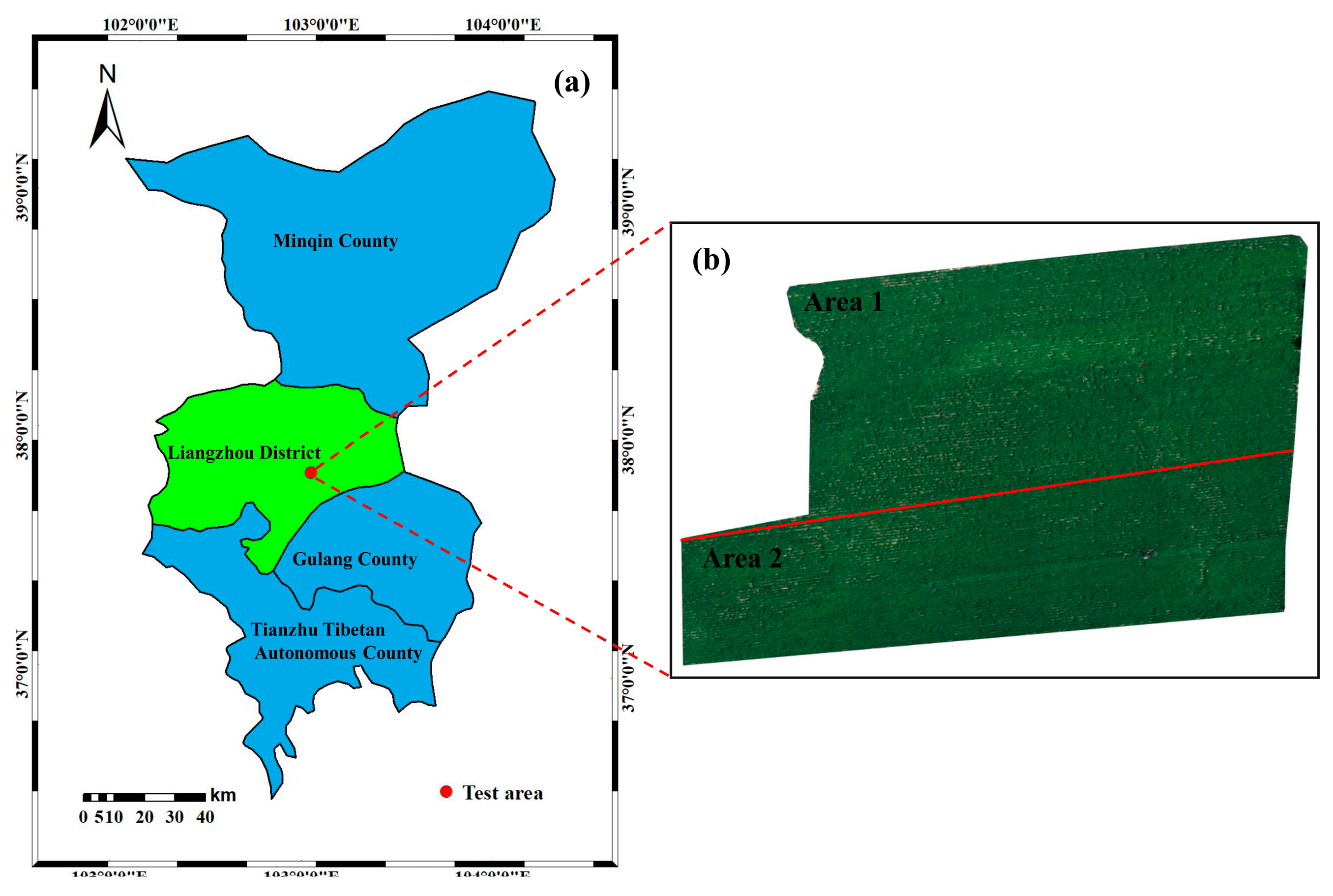

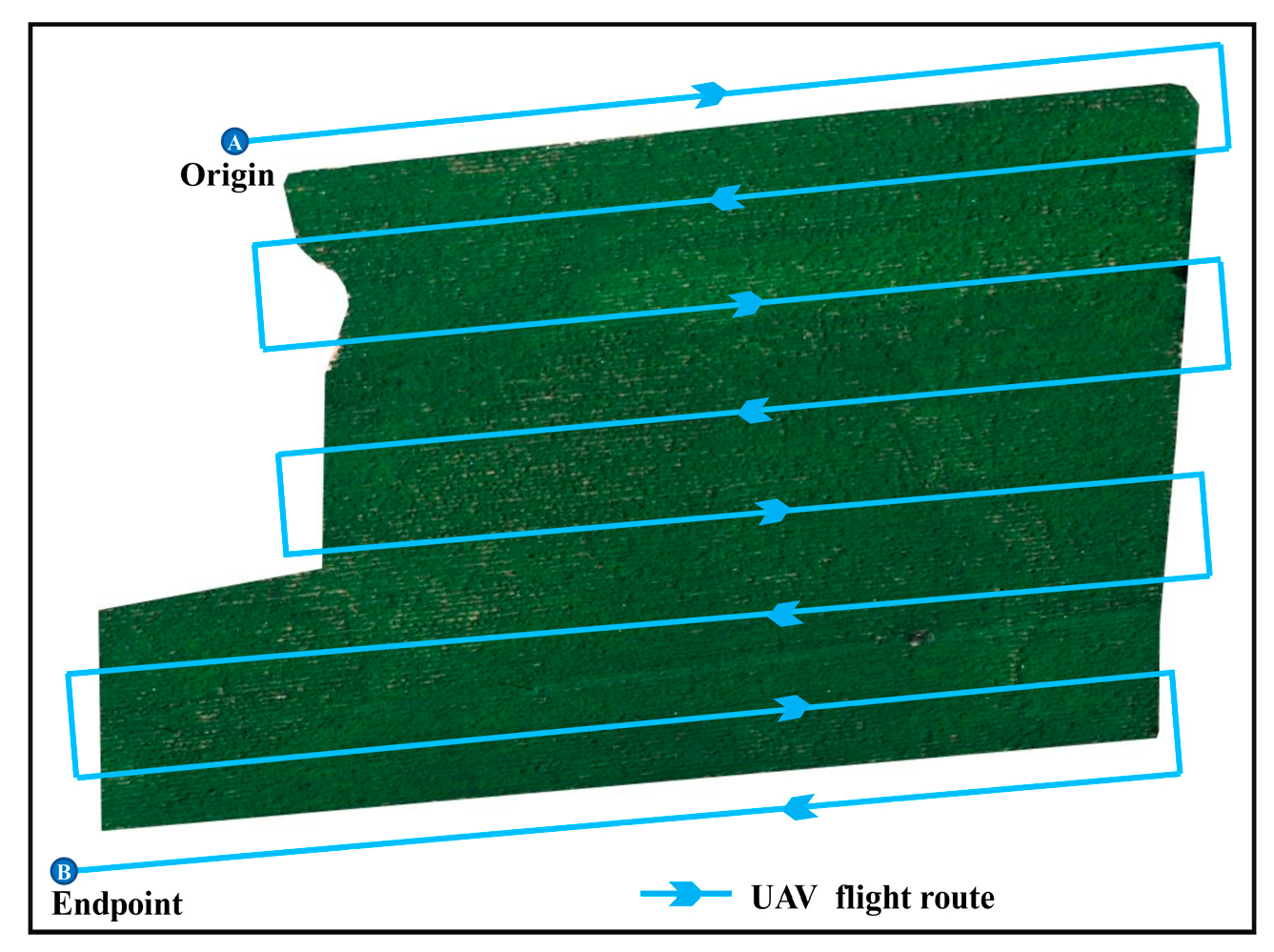

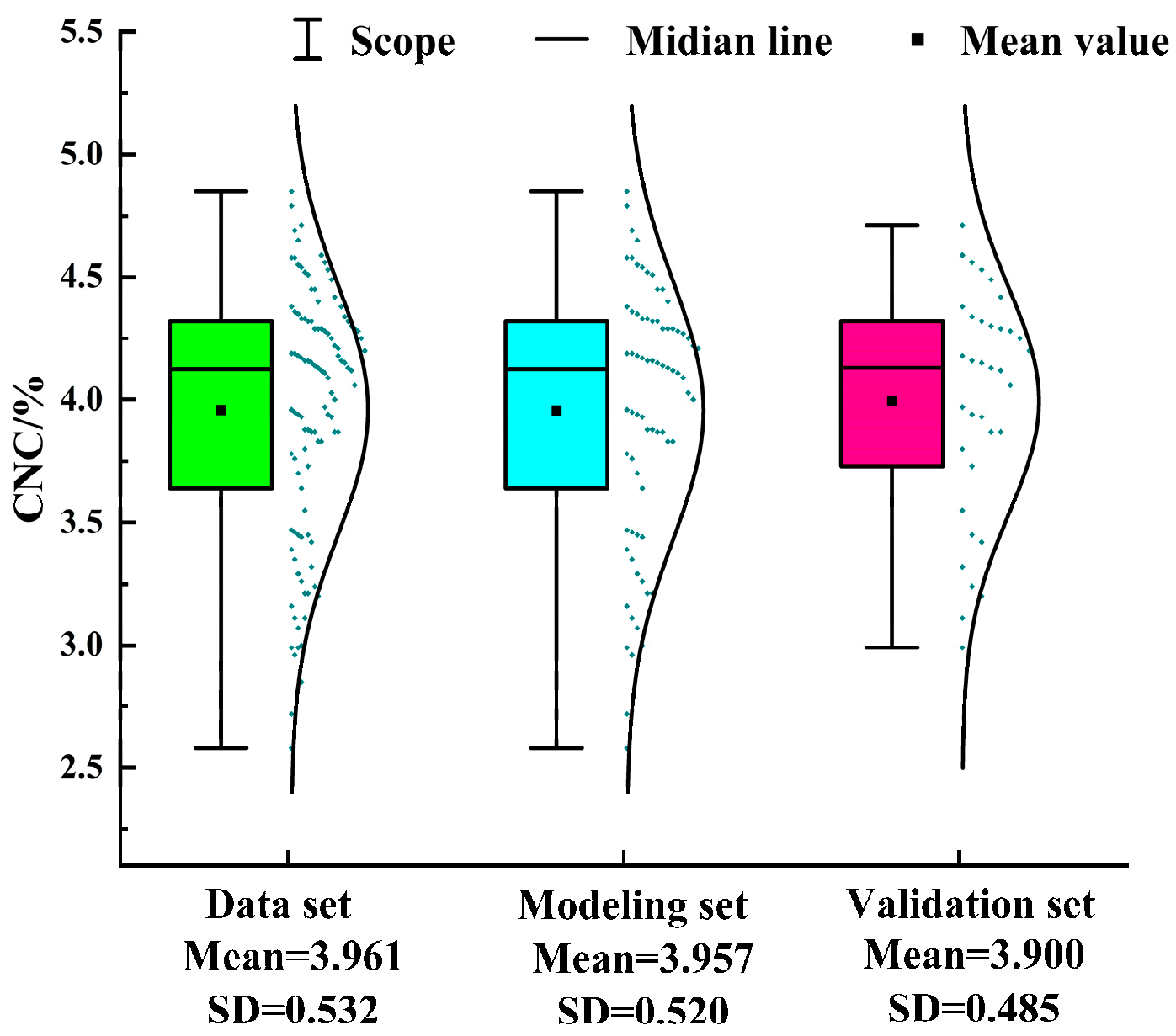

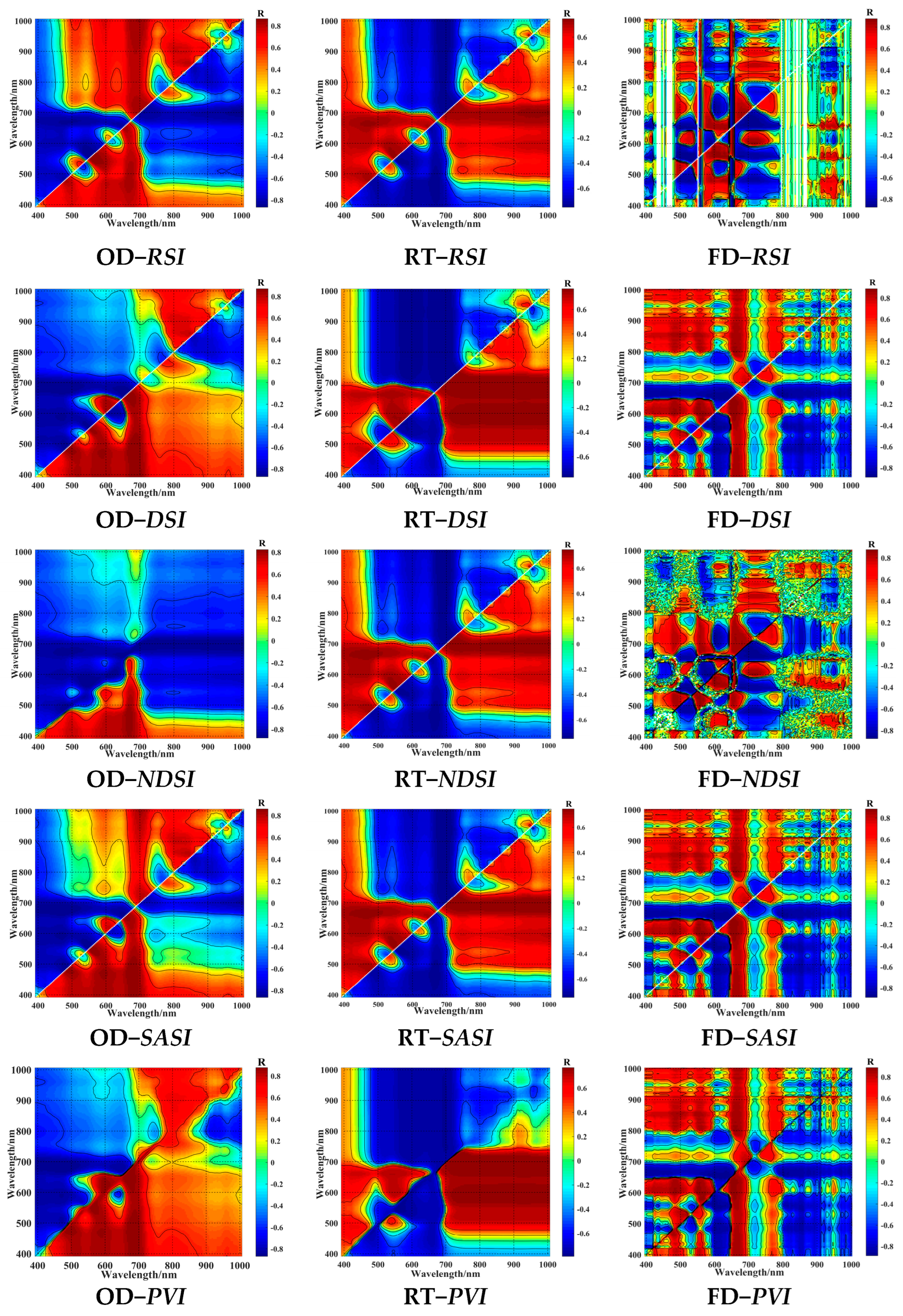

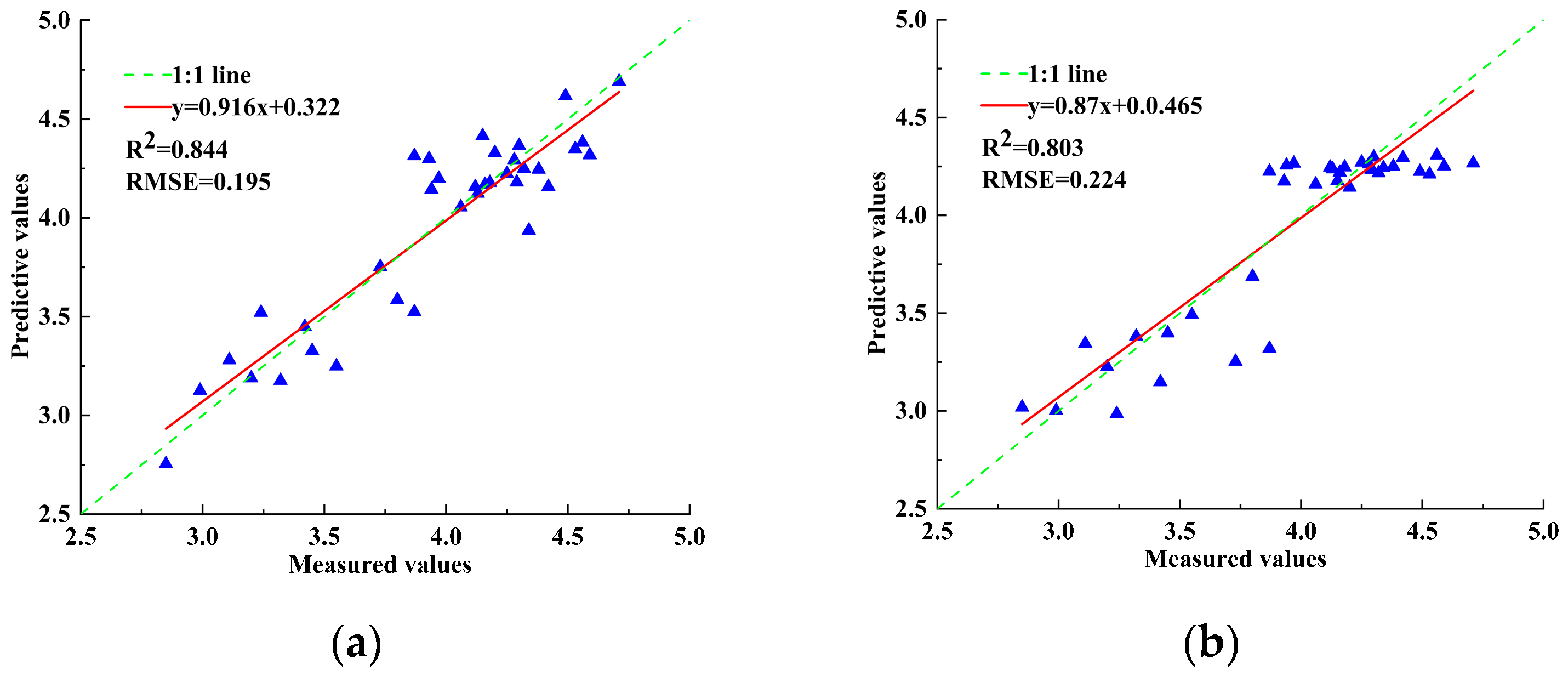

| Transform Spectrum | HIs | R | Transform Spectrum | HIs | R |
|---|---|---|---|---|---|
| OD | 0.87 | RT | 0.75 | ||
| 0.87 | 0.77 | ||||
| 0.82 | 0.75 | ||||
| 0.86 | 0.75 | ||||
| 0.88 | 0.77 | ||||
| FD | 0.88 | ||||
| 0.89 | |||||
| 0.88 | |||||
| 0.89 | |||||
| 0.89 |
| Transform Spectrum | HIs | Regression Equations | Modeling Set | Verification Set | ||
|---|---|---|---|---|---|---|
| R2 | RMSE/% | R2 | RMSE/% | |||
| OD | RSI | 0.75 | 0.26 | 0.73 | 0.25 | |
| DSI | 0.76 | 0.25 | 0.79 | 0.22 | ||
| NDSI | 0.72 | 0.28 | 0.75 | 0.24 | ||
| SASI | 0.74 | 0.26 | 0.77 | 0.23 | ||
| PSI | 0.77 | 0.25 | 0.77 | 0.23 | ||
| RT | RSI | 0.55 | 0.35 | 0.58 | 0.32 | |
| DSI | 0.59 | 0.33 | 0.58 | 0.31 | ||
| NDSI | 0.56 | 0.35 | 0.56 | 0.32 | ||
| SASI | 0.56 | 0.35 | 0.56 | 0.32 | ||
| PSI | 0.59 | 0.33 | 0.60 | 0.31 | ||
| FD | RSI | 0.77 | 0.25 | 0.68 | 0.28 | |
| DSI | 0.78 | 0.25 | 0.76 | 0.24 | ||
| NDSI | 0.77 | 0.25 | 0.67 | 0.28 | ||
| SASI | 0.79 | 0.24 | 0.78 | 0.23 | ||
| PSI | 0.79 | 0.24 | 0.76 | 0.24 | ||
| Variables | VIF | ||
|---|---|---|---|
| OD | RT | FD | |
| RSI | 8.62 | 6.46 | 4.17 |
| DSI | 4.96 | 3.73 | 5.66 |
| NDSI | 8.11 | 4.53 | 3.83 |
| SASI | 8.91 | 6.90 | 6.50 |
| PSI | 6.12 | 3.79 | 7.80 |
| Model | Regression Equations | Modeling Set | Verification Set | ||
|---|---|---|---|---|---|
| R2 | RMSE/% | R2 | RMSE/% | ||
| OD−PLSR | 0.77 | 0.25 | 0.80 | 0.22 | |
| RT−PLSR | 0.62 | 0.32 | 0.66 | 0.30 | |
| FD−PLSR | 0.80 | 0.23 | 0.80 | 0.24 | |
| OD−MLR | 0.78 | 0.25 | 0.80 | 0.23 | |
| RT−MLR | 0.62 | 0.33 | 0.66 | 0.30 | |
| FD−MLR | 0.84 | 0.22 | 0.84 | 0.20 | |
Disclaimer/Publisher’s Note: The statements, opinions and data contained in all publications are solely those of the individual author(s) and contributor(s) and not of MDPI and/or the editor(s). MDPI and/or the editor(s) disclaim responsibility for any injury to people or property resulting from any ideas, methods, instructions or products referred to in the content. |
© 2023 by the authors. Licensee MDPI, Basel, Switzerland. This article is an open access article distributed under the terms and conditions of the Creative Commons Attribution (CC BY) license (https://creativecommons.org/licenses/by/4.0/).
Share and Cite
Guo, F.; Feng, Q.; Yang, S.; Yang, W. Estimation of Potato Canopy Nitrogen Content Based on Hyperspectral Index Optimization. Agronomy 2023, 13, 1693. https://doi.org/10.3390/agronomy13071693
Guo F, Feng Q, Yang S, Yang W. Estimation of Potato Canopy Nitrogen Content Based on Hyperspectral Index Optimization. Agronomy. 2023; 13(7):1693. https://doi.org/10.3390/agronomy13071693
Chicago/Turabian StyleGuo, Faxu, Quan Feng, Sen Yang, and Wanxia Yang. 2023. "Estimation of Potato Canopy Nitrogen Content Based on Hyperspectral Index Optimization" Agronomy 13, no. 7: 1693. https://doi.org/10.3390/agronomy13071693
APA StyleGuo, F., Feng, Q., Yang, S., & Yang, W. (2023). Estimation of Potato Canopy Nitrogen Content Based on Hyperspectral Index Optimization. Agronomy, 13(7), 1693. https://doi.org/10.3390/agronomy13071693





